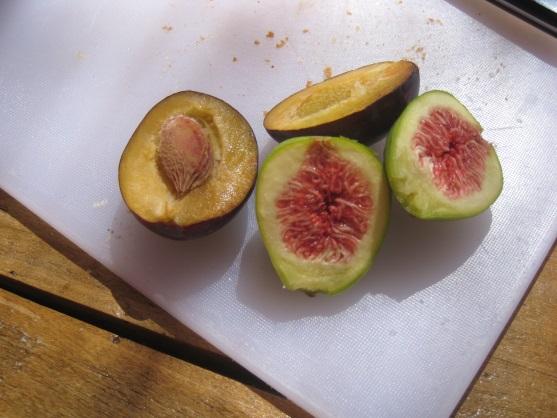Gran parte della migliore cucina tradizionale italiana è complessa e richiede tempo. Eppure, quando cucino nella casa nostra nelle Marche, la qualità dei prodotti, della carne, del formaggio, delle spezie di altri ingredienti è così alta che le preparazioni più semplici hanno un sapore fantastico. A fine estate, quando i mercati, qui e all'estero, sono inondati da abbondanti generosità della Terra, i prodotti disponibili negli Stati Uniti si avvicinano di più a quelli italiani. Naturalmente c'è ancora differenza. Il carattere dei sapori quando cucino in Italia è così soddisfacente che è difficile da eguagliare negli USA. Se bramate i sapori della campagna italiana, ora è il momento di approfittare dell'abbondanza del raccolto estivo. Intanto vi presentiamo, in tre puntate, tre semplici ricette ognuna delle quali utilizza un ingrediente principale e un'erba generalmente disponibile nei farmers' market o nei mercati di specialità.
Fichi con miele e aceto balsamico
Mentre in Italia crescono come le erbacce, sulla costa Est degli Usa è difficile trovare fichi freschi. Nella nostra proprietà nelle Marche abbiamo quattro alberi di fico sulla, ognuno dei quali è giunto a maturazione in meno di 3 anni. Ed è davvero uno dei motivi che abbiamo comprato casa in quella zona. L'amore per i fichi è chiaramente un passatempo nazionale in Italia: una volta siamo stati fermati dalla polizia nei pressi di Macerata per motivi che non abbiamo mai realmente capito; dopo aver accertato la nostra identità, una vivace conversazione sui fichi ha svelato una passione comune e il poliziotto ci ha fatti presto ripartire per la nostra strada. Purtroppo, sembra che non ci capiti mai di essere in Italia in estate, quando i fichi maturano, a luglio e a fine agosto-metà settembre . In verità il modo migliore per mangiare fichi freschi è coglierli direttamente dall'albero, sbucciarle e mangiarli lì, subito, caldi di sole. I fichi non sopportano bene gli spostamenti, e c'è poca domanda qui negli Stati Uniti: per questo che sono così difficili da trovare. E non troverete mai quelli verdi, grandi e succosi qui negli Stati Uniti, piuttosto saranno piccoli e impossibili da sbucciare. Ma se, come me, dovete a tutti i costi mangiarne qualcuno, c'è qualche negozio specializzato dove potete trovarne e questo è il momento dell'anno in cui acquistarli: Whole Foods, Eataly, Chelsea Market, Union Markets sono tutti posti dove provare .
Sapendo della mia passione per i fichi, un giorno, quest'estate, il nostro amico albanese ce ne ha portate due dozzine in uno scatolone foderato di foglie di fico – il metodo delle natura per un trasporto ottimale. Erano grandi come il pugno della mia mano, verdi all'esterno, rossi e succosi all'interno. Avendo nove persone a cena quella sera, mi sono inventata questo semplice dessert:
Fichi con miele e aceto balsamico
In una piccola ciotola, sbattete insieme 1/3 c (75 ml) di miele, 1 cucchiaio di aceto balsamico, e 1 cucchiaino di foglie di timo fresco. Assaggiate e regolate rei sapori. Questa salsa può essere preparata in anticipo. Al momento di servire, con un mixer a mano unite un 8 oz (250 g) di mascarpone e 2 cucchiai di miele. Lavate delicatamente i fichi (se ne hanno bisogno) e asciugateli o sbucciateli con attenzione. Tagliateli a metà longitudinalmente. Posizionate 2-6 metà su ogni piatto da dessert. Irrorate con il miele e lo sciroppo balsamico e guarnite con una cucchiaiata di mascarpone.
A proposito di miele: le api in Italia sono protette e, intorno alla nostra casa, hanno vissuto da sempre e non vedono il nostro arrivo come un motivo per andarsene. Lo spazio tra la porta e le imposte della nostra camera da letto al secondo piano è per loro il rifugio perfetto per un enorme alveare che hanno fatto in quel punto due volte finora. Per fortuna conosciamo tre apicoltori. La mia amica Robyn non può credere che conosciamo tre apicoltori: tre idraulici, tre dentisti, certo, ma tre apicoltori? Per fortuna sono venuti in nostro soccorso due volte e sono ben contenti di far traslocare le nostre api, per le quali ci hanno ripagato con miele fatto in casa. Il processo di rimozione delle api richiederebbe di scrivere un'altra storia, ma per la nostra generosità siamo stati premiati con tre varietà di miele: mille fiori, castagne (un miele più scuro, sia nel colore che nel sapore, realizzato da fiori di castagno) e acacia, leggero e fruttato. Per questo dessert ho utilizzato il miele di acacia. Troverete molti apicoltori locali che vendono miele nei mercati agricoli qui negli Stati Uniti, ma attenzione: il miele qui è molto più pesante e spesso e il gusto non è così rinfrescante.
Fiori di zucca fritti
I fiori di zucca si trovano nei mercati del contadino a fine estate e in primavera. E sono facili da preparare: utilizzando 3 cucchiai colmi di farina e mezza lattina o bottiglia di birra (circa 200 ml) preparate una pastella. Mescolate con una forchetta fino a che si forma una pasta morbida e liquida. Lasciatela riposare per circa 15 minuti. Nel frattempo tagliate circa 175 grammi di mozzarella fresca a listelli piccoli. Aprite delicatamente i petali dei fiori di zucca e rimuovete i pistilli con le unghie. Inserite un pezzo di mozzarella in ogni fiore e attorcigliatene le estremità in modo da chiudere i petali. Cospargete abbondantemente una padella antiaderente piuttosto ampia di olio d'oliva e mettete su fuoco vivo.
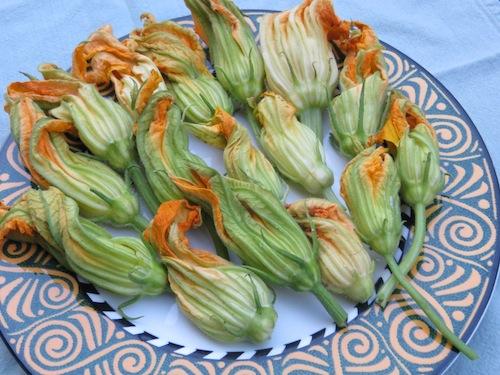
Immergete i fiori nella pastella, rigirandoli delicatamente fino a che non sono completamente coperti. Immergete i fiori nell'olio caldo. Lasciate cuocere fino a doratura, ribaltandoli una sola volta. Togliete dal fuoco e metteteli a scolare su carta assorbente. Cospargete con prezzemolo fresco tritato e servite subito, accompagnati da spicchi di limone.
Pasta con zucchine e menta
Non so perché l'aglio in Italia è molto più forte e più saporito che negli Stati Uniti. Quando cucino in Italia io non uso mai più di uno spicchio d'aglio per ogni piatto, mentre negli USA raramente ne uso meno di tre, anche quando trovo l'aglio fresco al farmers' market. Stessa cosa con le erbe aromatiche. Qualche foglia di salvia o basilico del mio orto in Italia è sufficiente a darmi tanto sapore quanto una manciata del mio giardino a Brooklyn. Sarà il sole, sarà il suolo, ma regolate le vostre ricette di conseguenza.
Nel mio giardino a Brooklyn, quest'anno, ho piantato una varietà di menta chiamata apple mint. Le foglie sono grandi e morbide, con le estremità arrotondate e il sapore è fantastico. Il mio solito amico albanese nelle Marche mi ha portato un po 'di menta romana. La pianta aveva solo qualche rametto di foglie verdi e un grosso gomitolo di radici avvolte nel fango dall'aspetto un po' ostile. L'ho piantata fuori dalla mia cucina e nel giro di pochi giorni, decine di piccoli germogli verdi hanno cominciato a venire fuori dal terreno. La menta romana è probabilmente la varietà più simile alla spearmint che si trova negli States. Anche in questo caso, basta qualche foglia italiana lì dove è necessaria una grossa manciata della qualità americana.
Mettete a bollire una grossa pentola di acqua salata e fate cuocere 500 grammi di pasta corta. Nel frattempo, in un pentolino o nel forno, tostate circa ½ tazza (100 ml) di noci tritate fino a che diventano dorate e croccanti. Tagliate a disco 3 grosse zucchine (o 4 di medie dimensioni). Riscaldate ½ tazza (125 ml ) di olio d'oliva in una padella media. Aggiungete 2-3 spicchi d'aglio tagliati e soffriggete fino a doratura. Aggiungete le zucchine e 2 grandi manciate di foglie di menta lavate, asciugate e private dei gambi. Io tengo la fiamma alta in modo da far imbrunire le zucchine. Aggiustate di sale e pepe. Scolate la pasta e buttatela in padella insieme al condimento e alle noci tostate. Servite con parmigiano grattugiato. Buon appetito!
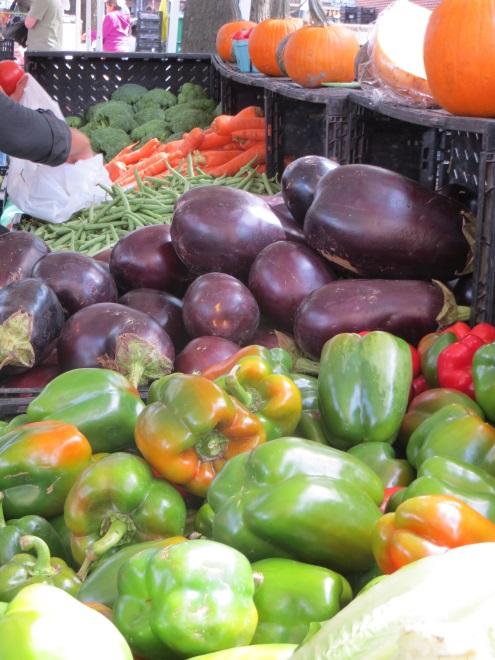

Much of the best traditional Italian cooking is complex and time consuming. Yet when I cook at our house in LeMarche, the quality of the produce, meat, cheese, herbs and other ingredients is so high, the simplest preparations taste fantastic. Now in late summer, when the markets here and abroad overflow with Earth’s bounty, produce available in the U.S. most closely resembles that of Italy. There are of course still differences. The pungency of flavors when I cook in Italy is so satisfying, it’s hard to match in the U.S. If you long for the tastes of the Italian countryside, now is the time to take advantage of the abundance of the summer harvest. Here are three simple recipes each utilizing one main ingredient and one herb generally available in farm or specialty markets.
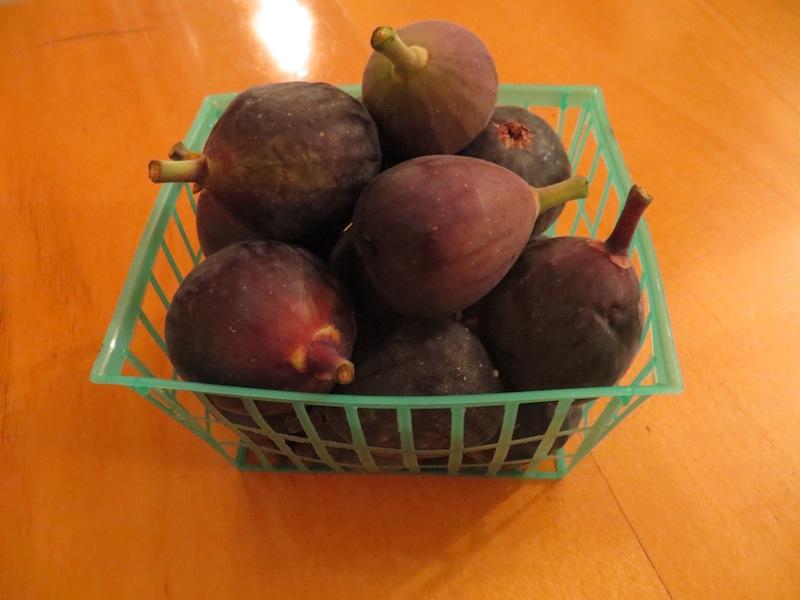
Figs bought in the U.S.
Though they grow like weeds in Italy, it is difficult to find fresh figs on the east coast in the U.S. We have four fig trees on our property in Le Marche, each of which matured in less than 3 years. It is truly one of the reasons we bought a house there. Love of figs is clearly a national pastime in Italy– we were once stopped by the police near Macerata for reasons we never quite understood. After establishing our identity, a lively conversation about figs revealed a shared passion and the police soon waved us on our way. Unfortunately, it seems we’re never in Italy either time in summer when the figs are ripe—July and late August-mid-September. Really the best way to eat fresh figs is to pick them off the tree, peel them and eat them right then and there, warm from the sun. Figs don’t travel well, and there is little demand for them here in the U.S., which is why they are so hard to find. And you will never find those big juicy green ones here in the States—rather they will be small and impossible to peel. But, if like me, you must have some, there are a few specialty markets that carry them and this would be the time of year to buy. Whole Foods, Eataly, Chelsea Market, Union Markets are all good places to try.
Knowing my craving for figs, our Albanian friend brought us about 2 dozen one day this summer in a carton lined with fig leaves—nature’s way for optimal transport. They were big as my fist—green on the outside; juicy red within. With nine coming for dinner that night, I came up with this simple dessert:
Figs with honey and balsamic
In a small bowl, whisk together 1/3 c (75 ml) honey, 1 T balsamic vinegar, and 1 tsp fresh thyme leaves. Taste and adjust flavors. This can be done in advance. When ready to serve, use a hand mixer to combine one 8 oz (250 g) container of mascarpone and another 2 T of honey. Gently wash the figs (if they need it) and pat dry, or peel them carefully. Cut in half lengthwise. Set 2-6 fig halves on each dessert plate. Drizzle with the honey/balsamic syrup and top with a dollop of the mascarpone.
About honey. Bees are protected in Italy. Bees have been living around our house for centuries and see our occupancy as no reason to move on. They find the space between the door and shutter of our second floor bedroom the perfect haven to build an enormous hive, which they’ve done now on two occasions. Luckily, we happen to know three beekeepers. My friend Robyn can’t believe we know three beekeepers. Three plumbers, three dentists, sure, but three beekeepers? Blessedly they have come to our rescue twice and been delighted to relocate our bees, for which they’ve repaid us with homemade honey. The process of removing the bees is another story, but for our generosity we were treated to three varieties of honey—mille fiori (which I think just translates to “random”); castagna, a darker honey both in color and flavor made from the blossoms of chestnut trees; and acacia, which is light and fruity. I used the acacia honey in this dessert. You will find many local beekeepers selling honey at farm markets here in the U.S., but beware—the honey here is much heavier and thicker—the taste is not quite as refreshing.
Fried zucchini flowers
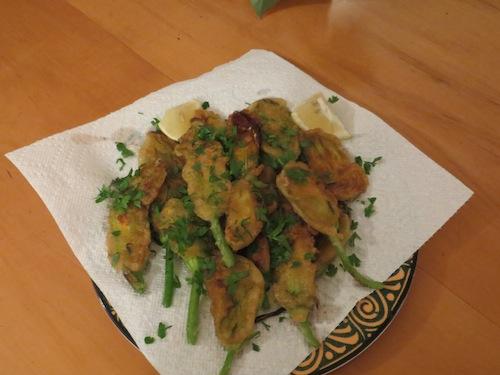
These can be found in farm markets this time of year and in spring. And they are easy to make: prepare a batter using about 3 heaping tablespoons of flour and ½ can or bottle of beer—about 6 fl oz (200 ml). Mix together with a fork until a smooth, runny batter forms. Let the batter sit for about 15 minutes. In the meantime, cut about ¼ lb (175 g) fresh mozzarella into small batons, about 1” x ½” x ½”. Gently open the petals of the zucchini flowers and remove the pistil using your fingernail. Insert one piece of mozzarella into each flower and twist the petals together to seal.
Thickly coat a large non-stick skillet with olive oil over high heat. Dip each flower into the batter, turning gently until completely coated. Place flowers in the pan as they’re dipped and brown until golden, turning once. Remove and place on paper towel to drain. Sprinkle with chopped fresh parsley and serve immediately with lemon wedges.
Pasta with zucchini and mint
I don’t know why the garlic in Italy is so much stronger and more flavorful than here in the U.S. When I cook in Italy, I never use more than one clove of garlic in any dish; in the U.S. I rarely use less than three, even when they are fresh from the farm market. The same is true of herbs. From my garden in Italy, a few leaves of sage or basil provide as much seasoning as a large handful from my garden in Brooklyn. Maybe it’s the sun, maybe it’s the soil, but adjust your recipes accordingly.

In my Brooklyn garden this year, I grew a variety of mint called apple mint. The leaves were large and soft, with rounded ends and the flavor was excellent. My same Albanian friend in Le Marche brought me some menta romana. This plant had only a few sprigs of green leaves and a slightly intimidating, giant coil of mud-clotted roots. I planted it outside my kitchen and within a few days, dozens of little green shoots were sprouting through the soil. Menta romana is probably closest to spearmint in the States. Again, a few leaves in Italy suffice where a big handful is needed in the U.S.
Boil a large pot of salted water and cook 1 lb or 500 grams of short pasta. In the meantime, toast about ½ cup (100 ml) of chopped walnuts in a small pan or toaster oven until just browned and fragrant. Using a mandoline, slice 4 large or 3 medium zucchini into thin disks. Heat ½ cup (125 ml) of olive oil in a medium sauté pan. Add 2-3 cloves of garlic, sliced, and sauté until golden. Add the zucchini and 2 large handfuls of mint leaves, washed, dried and removed from their stems. I keep the heat high so the zucchini browns a bit. Season generously with salt and pepper. Toss together with drained pasta and the walnuts and serve with parmigiano. Buon appetito!
*Gabrielle Walker vive a Brooklyn ma ha una casa nelle Marche dove spesso trascorre parte dell'estate / Gabrielle Walker lives in Brooklyn and has a house in Le Marche where she often spends her holidays.
